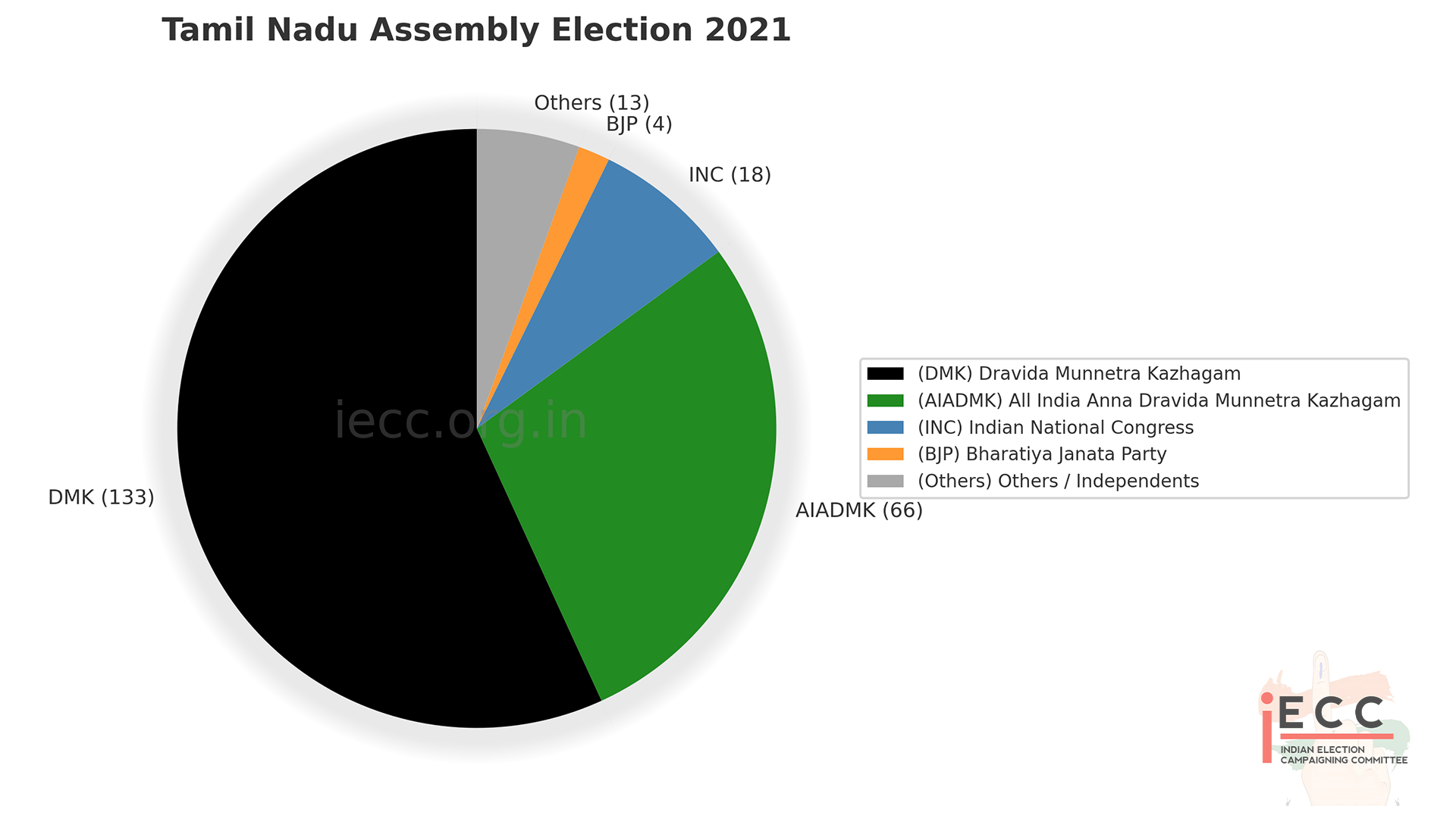Tamil Nadu Assembly Election
1952 Tamil Nadu Legislative Assembly Election Results
| 1952 Tamil Nadu Assembly Election Results | |||
|---|---|---|---|
| Sr. No. | Short Name | Full Name | Seats |
| 1 | INC | Indian National Congress | 152 |
| 2 | CPI | Communist Party of India | 62 |
| 3 | Independent candidates | Independent candidates | 74 |
| 4 | (KMPP) | Kisan Mazdoor Praja Party | 35 |
| 5 | Forward Bloc | Forward Bloc | 15 |
| 6 | SCF, Ambedkar’s party | Scheduled Castes Federation | 5 |
| 7 | Others | Others | 32 |
| Total | 375 | ||
This was the first-ever assembly election in Tamil Nadu (then Madras State) after India’s independence.
The INC failed to secure a majority (152 seats vs. 188 needed).
Independents and smaller parties (CPI, KMPP, Forward Bloc, SCF) had a significant presence.
Despite Congress’s weak performance, C. Rajagopalachari (Rajaji) was invited to form the government as Chief Minister with outside support.
This election marked the rise of the Communist Party in Tamil Nadu politics, which became the main opposition.
It also showed the fragmented political scenario before the dominance of Dravidian parties (which began in 1967 with DMK).
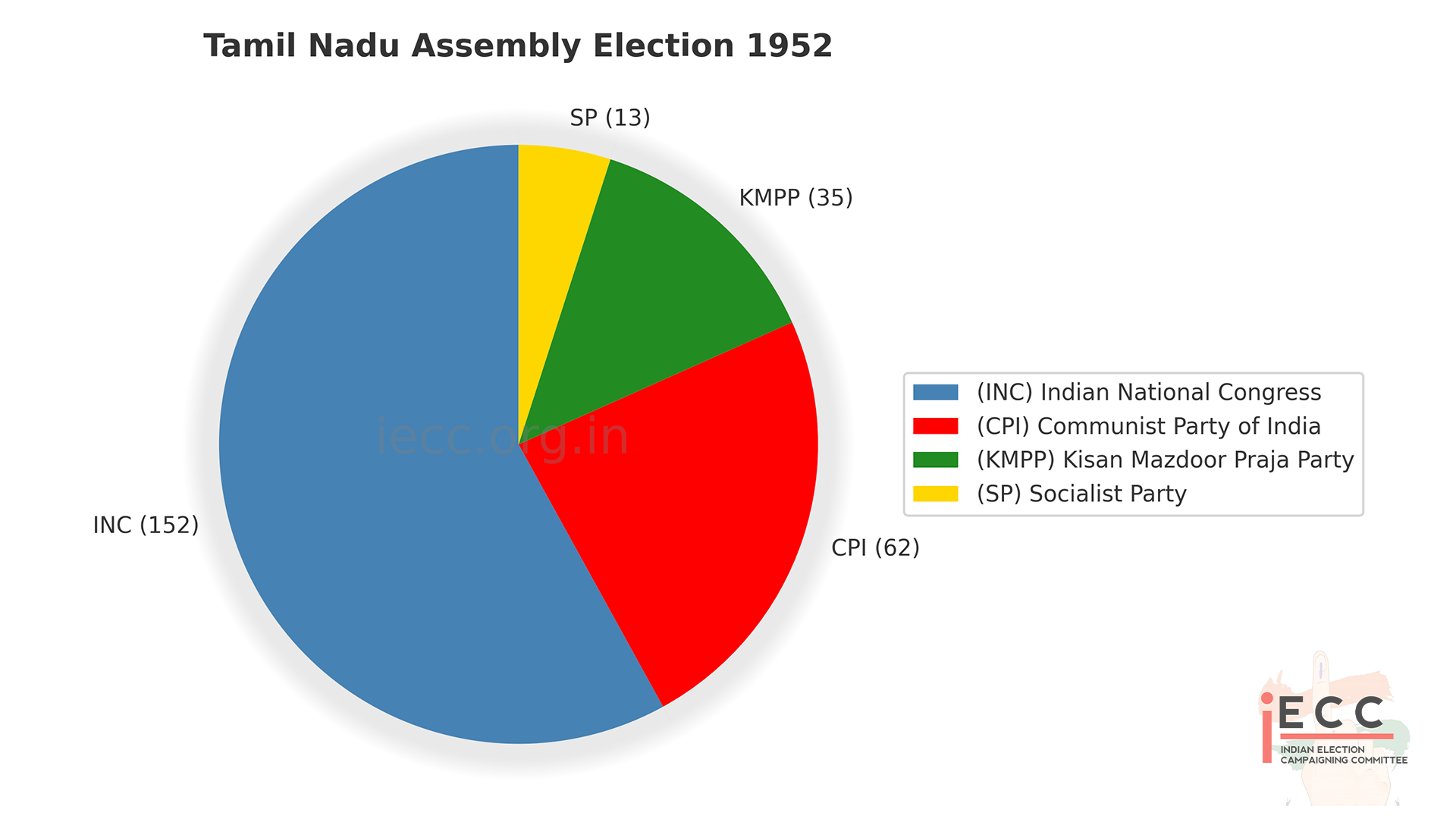
1957 Tamil Nadu Legislative Assembly Election Results (Projected)
| 1957 Tamil Nadu Assembly Election Result (Forecast) | |||
|---|---|---|---|
| Sr. No. | Short Name | Full Name | Seats |
| 1 | INC | Indian National Congress | 151 |
| 2 | CPI | Communist Party of India | 4 |
| 3 | DMK | Dravida Munnetra Kazhagam | 15 |
| 4 | Independents | Independents | 34 |
| 5 | Others | Others | 1 |
| Total | 205 | ||
This was the first Assembly election after the States Reorganisation Act (1956), which created a smaller Madras State by carving out Andhra Pradesh, Kerala, and parts of Karnataka.
The Indian National Congress (INC), led by K. Kamaraj, secured a clear majority (151 seats) and formed the government.
K. Kamaraj became Chief Minister in 1957, remembered for his focus on education (free midday meals, school construction) and rural development.
The DMK (Dravida Munnetra Kazhagam), contesting its first election, made a strong debut with 15 seats, signaling the rise of Dravidian politics.
The Communists (CPI), who were stronger in 1952, saw their influence weaken.
Independents continued to win a significant number (34), reflecting local-level politics still playing a big role.
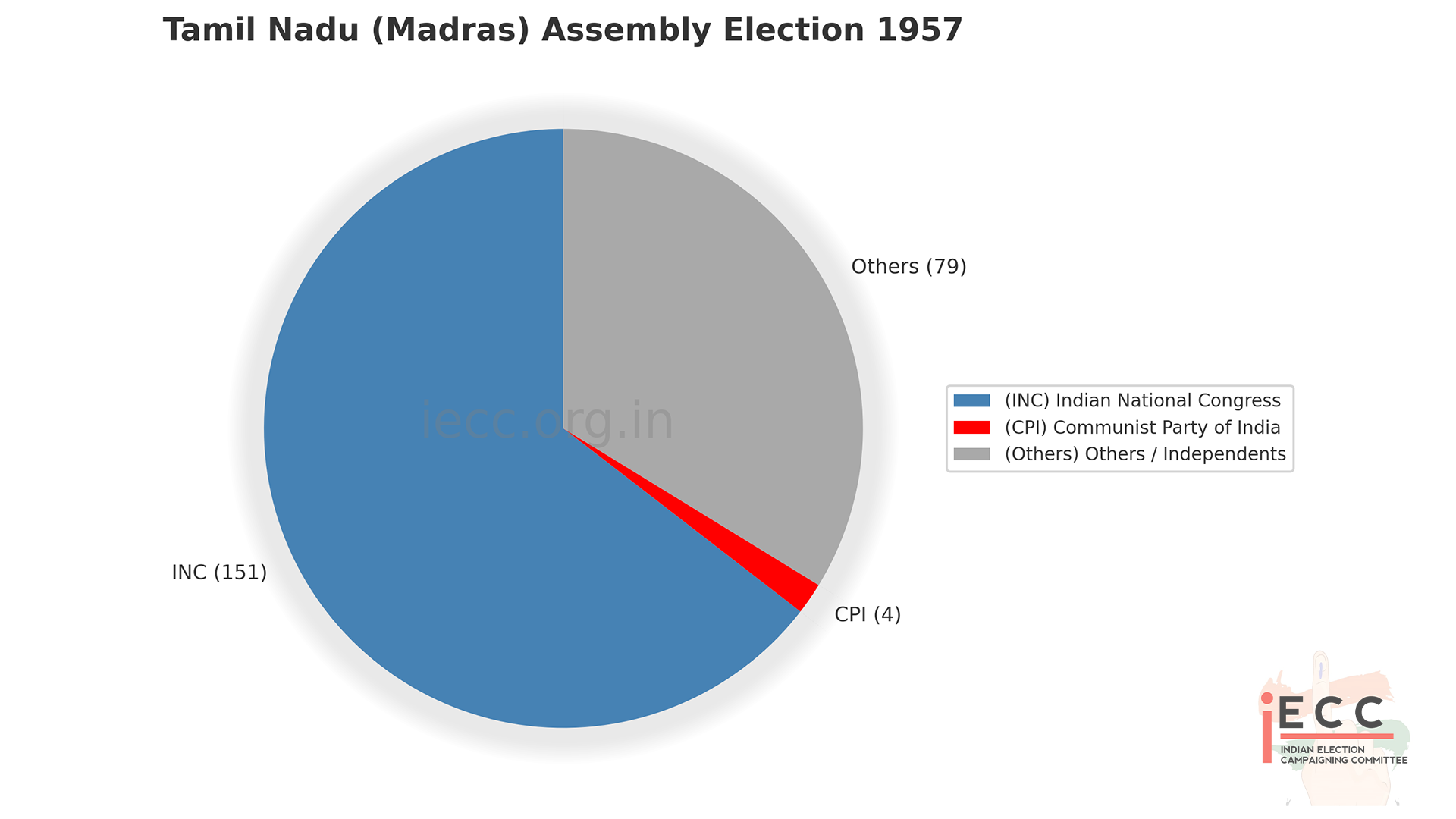
1962 Tamil Nadu Legislative Assembly Election Results (Projected)
| 1962 Tamil Nadu Legislative Assembly Election Results (Projected) | |||
|---|---|---|---|
| Sr. No. | Short Name | Full Name | Seats |
| 1 | INC | Indian National Congress | 139 |
| 2 | DMK | Dravida Munnetra Kazhagam | 50 |
| 3 | CPI | Communist Party of India | 4 |
| 4 | Swatantra Party | Swatantra Party | 6 |
| 5 | Independents & Others | Independents & Others | 6 |
| Total | 205 | ||
The INC (under K. Kamaraj) once again secured a comfortable majority (139 seats).
K. Kamaraj became Chief Minister for the second time. His governance was praised for:
Expanding education through school construction and mid-day meal schemes.
Strong rural development and infrastructure projects.
The DMK emerged as the main opposition with 50 seats, showing rapid growth since its first contest in 1957 (15 seats).
This marked the beginning of the decline of Congress dominance in Tamil Nadu, as DMK steadily gained popularity with its Dravidian ideology, Tamil pride, and anti-Congress campaigns.
The Swatantra Party (newly formed by C. Rajagopalachari) entered the fray and secured a small foothold (6 seats).
Communists saw further decline compared to the 1952 election
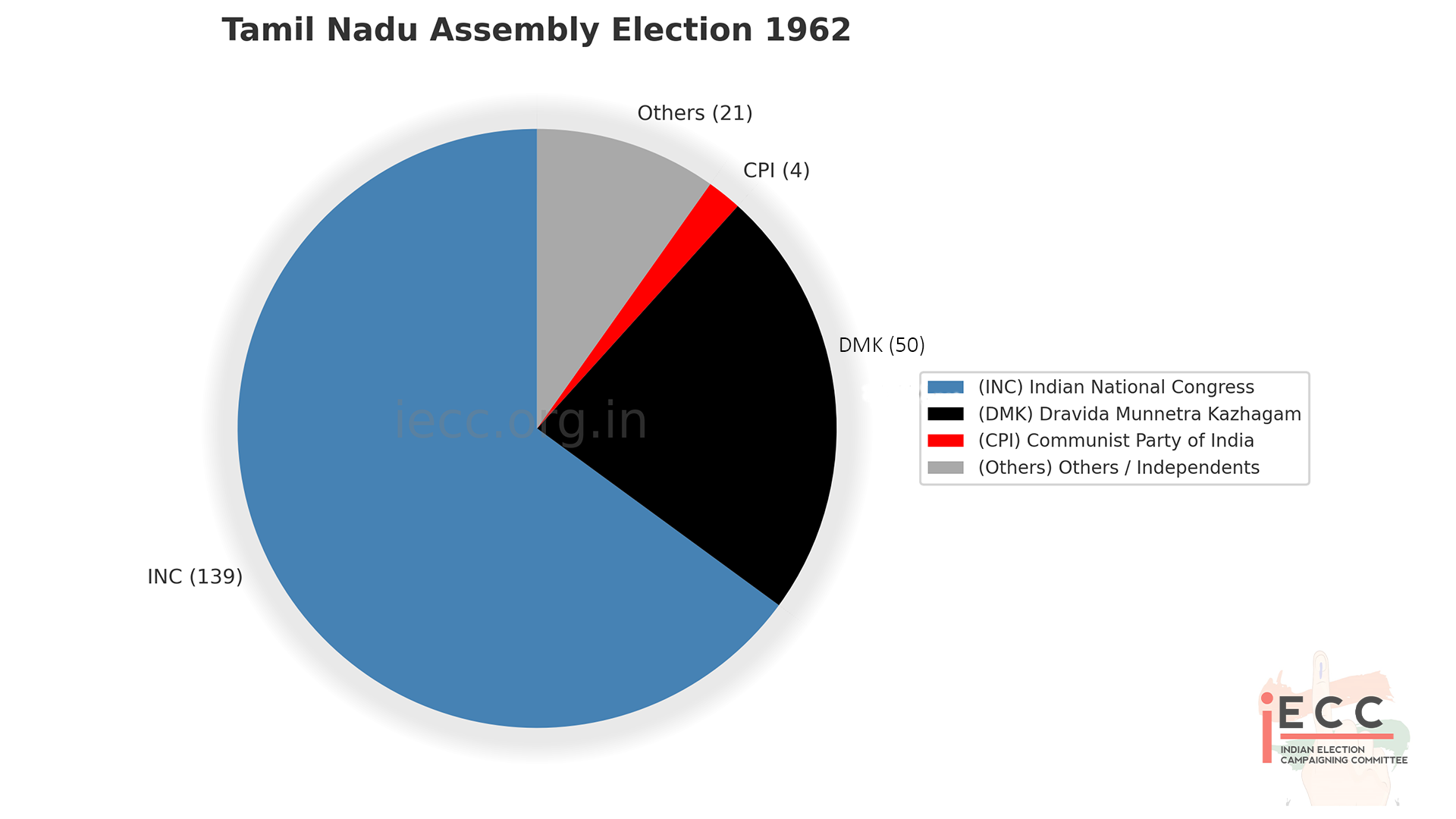
1967 Tamil Nadu Legislative Assembly Election Results
| 1967 Tamil Nadu Legislative Assembly Election Results | |||
|---|---|---|---|
| Sr. No. | Short Name | Full Name | Seats |
| 1 | DMK | Dravida Munnetra Kazhagam | 138 |
| 2 | INC | Indian National Congress | 51 |
| 3 | Swatantra Party | Swatantra Party | 20 |
| 4 | Forward Bloc | Forward Bloc | 11 |
| 5 | (Marxist) CPI(M) | Communist Party of India | 9 |
| 6 | CPI | Communist Party of India | 4 |
| 7 | Others / Independents | Others / Independents | 1 |
| Total | 234 | ||
The 1967 election ended the dominance of the Congress in Tamil Nadu (and first such defeat in any major Indian state).
The DMK, led by C. N. Annadurai, won 138 seats and formed the government.
C. N. Annadurai became the first non-Congress Chief Minister of Tamil Nadu.
The Congress was reduced to 51 seats, a shocking defeat after ruling continuously since Independence.
This election was driven by:
Strong anti-Hindi agitation (1965) that mobilized Tamil pride.
Discontent against Congress leadership, corruption, and central dominance.
The alliance of DMK with Swatantra Party, Forward Bloc, CPI, CPI(M) which consolidated anti-Congress votes.
This election marked the beginning of Dravidian dominance in Tamil Nadu politics – a trend that continues even today (DMK & AIADMK alternating power).
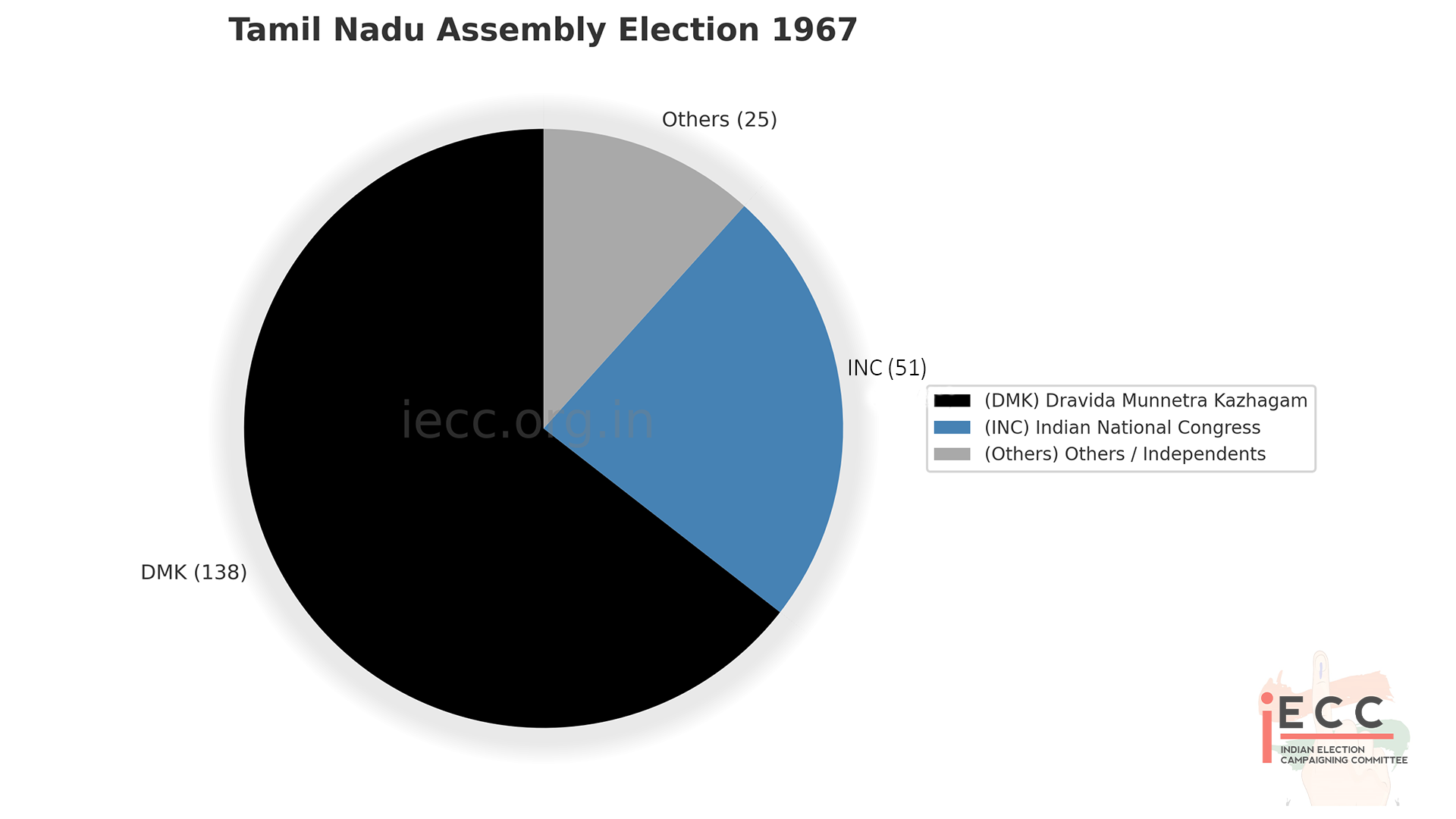
1971 Tamil Nadu Legislative Assembly Election Results
| 1971 Tamil Nadu Legislative Assembly Election Results | |||
|---|---|---|---|
| Sr. No. | Short Name | Full Name | Seats |
| 1 | DMK | Dravida Munnetra Kazhagam | 184 |
| 2 | (Organisation) [Congress (O)] | Indian National Congress | 15 |
| 3 | (Indira) [Congress (I)] | Indian National Congress | 0 |
| 4 | Forward Bloc | Forward Bloc | 9 |
| 5 | PSP | Praja Socialist Party | 2 |
| 6 | CPI | Communist Party of India | 0 |
| 7 | Independents & Others | Independents & Others | 24 |
| Total | 234 | ||
The DMK, under M. Karunanidhi, swept the 1971 election with a massive 184 seats out of 234.
This was the first election after the death of C. N. Annadurai (1969). M. Karunanidhi took over as Chief Minister and sought his own mandate.
The INC had split in 1969 into:
Congress (O) led by K. Kamaraj in Tamil Nadu.
Congress (I) led by Indira Gandhi at the national level.
Indira Gandhi’s Congress (I) allied with DMK, which gave DMK an overwhelming advantage.
The Congress (O) under Kamaraj was badly defeated, securing only 15 seats.
This election consolidated DMK’s dominance and showed the irreversible decline of the Congress in Tamil Nadu.
The DMK’s victory was also supported by its Dravidian ideology, anti-Congress sentiment, and alliance with Indira Gandhi, who was at her political peak nationally.
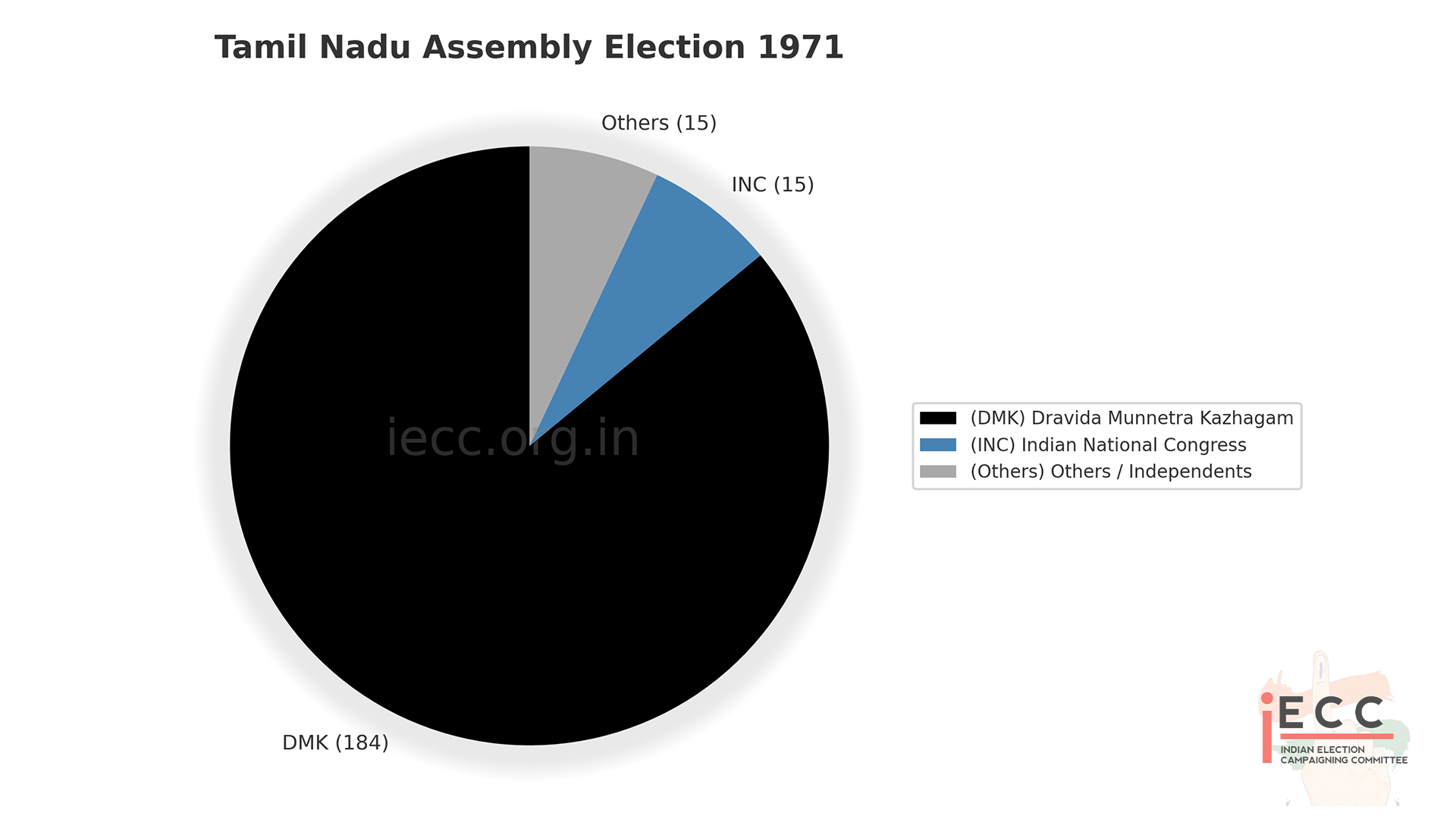
1977 Tamil Nadu Legislative Assembly Election Results
| 1977 Tamil Nadu Legislative Assembly Election Results | |||
|---|---|---|---|
| Sr. No. | Short Name | Full Name | Seats |
| 1 | AIADMK | All India Anna Dravida Munnetra Kazhagam | 130 |
| 2 | DMK | Dravida Munnetra Kazhagam | 48 |
| 3 | (Indira) [INC(I)] | Indian National Congress | 27 |
| 4 | (Organisation) [INC(O)] | Indian National Congress | 0 |
| 5 | (Marxist) CPI(M | Communist Party of India | 12 |
| 6 | Others / Independents | Others / Independents | 8 |
| Total | 225 | ||
The 1977 election was the first Assembly election after the Emergency (1975–77), which had created strong anti-Congress sentiments across India.
M. G. Ramachandran (MGR), a hugely popular film star who had split from the DMK in 1972 to form the AIADMK, led his party to a historic victory with 130 seats.
The DMK, led by M. Karunanidhi, was reduced to just 48 seats, suffering due to anti-incumbency, corruption allegations, and MGR’s mass popularity.
The INC(I), aligned with DMK, managed only 27 seats, reflecting Congress’s continued decline in Tamil Nadu.
The Communist parties (CPI & CPI(M)) retained small but notable influence.
MGR became the Chief Minister, the first film actor in India to head a state government.
This election marked the permanent split in Dravidian politics between DMK and AIADMK, a rivalry that continues to dominate Tamil Nadu politics.
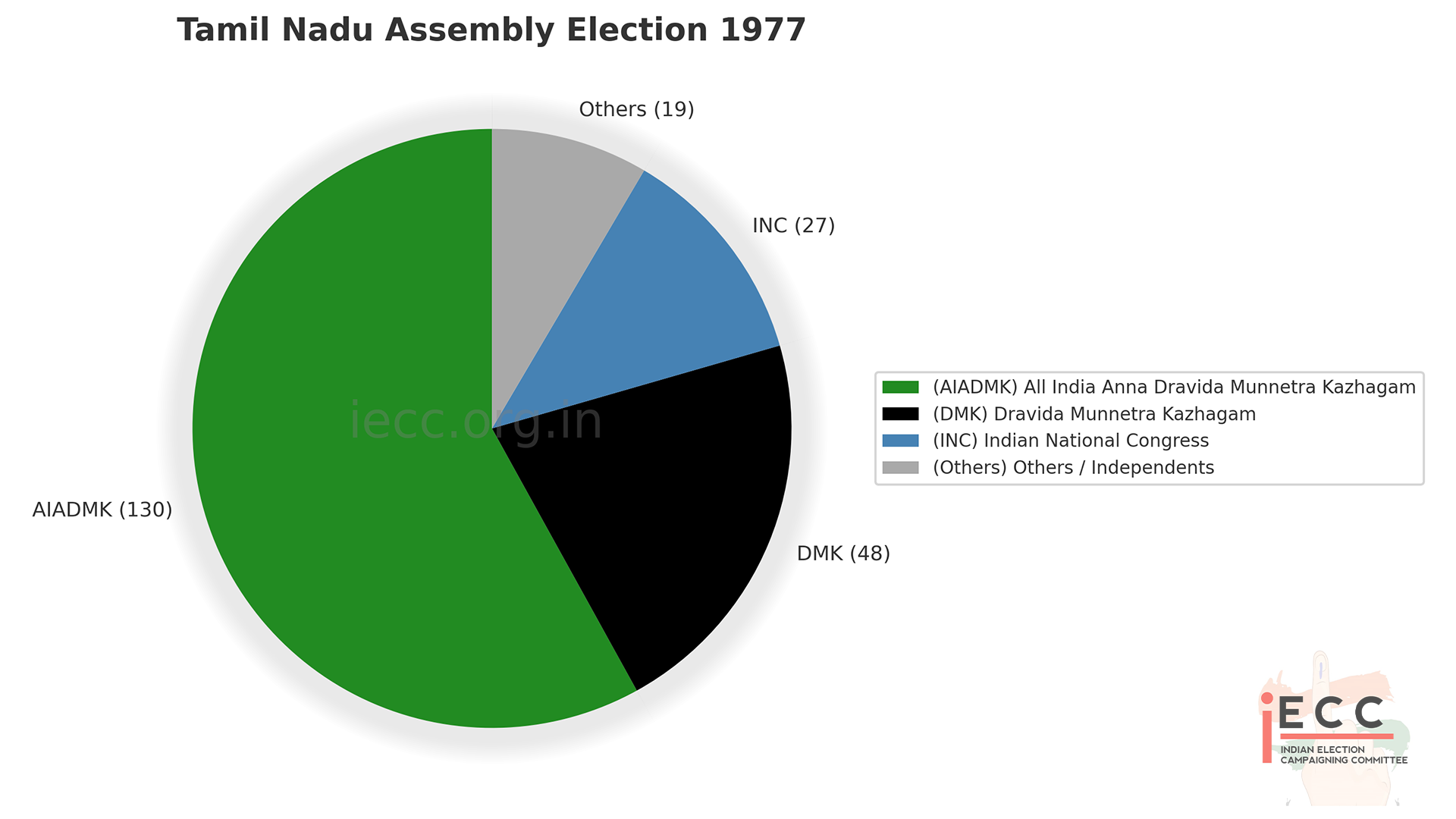
1980 Tamil Nadu Legislative Assembly Election Results
| 1980 Tamil Nadu Legislative Assembly Election Results | |||
|---|---|---|---|
| Sr. No. | Short Name | Full Name | Seats |
| 1 | AIADMK | (All India Anna Dravida Munnetra Kazhagam) + Indira Congress [INC(I)] | 162 |
| 2 | DMK | (Dravida Munnetra Kazhagam) | 37 |
| 3 | (Organisation) [INC(O)] | Indian National Congress | 0 |
| 4 | CPI | Communist Party of India | 9 |
| 5 | (Marxist) CPI(M) | Communist Party of India | 9 |
| 6 | Others / Independents | Others / Independents | 17 |
| Total | 234 | ||
The 1980 election was held just three years after the 1977 election, because the MGR-led government was dismissed by the Central Government (Indira Gandhi’s INC-I) in early 1980.
Instead of being weakened, MGR and AIADMK came back stronger, forming a pre-poll alliance with Indira Gandhi’s Congress (I).
Together, the AIADMK–Congress (I) alliance swept 162 seats, giving MGR a decisive mandate
The DMK, led by M. Karunanidhi, managed only 37 seats, a major setback.
This victory showed MGR’s personal charisma, popularity from his cinema career, and his strong welfare schemes, including:
Midday meal program expansion (nutritious meal scheme for schoolchildren).
Pro-poor populist policies.
With this win, MGR became Chief Minister again, consolidating his position as one of the most popular leaders in Tamil Nadu’s history.
This election confirmed that AIADMK had firmly overtaken DMK as the dominant Dravidian party at that time.
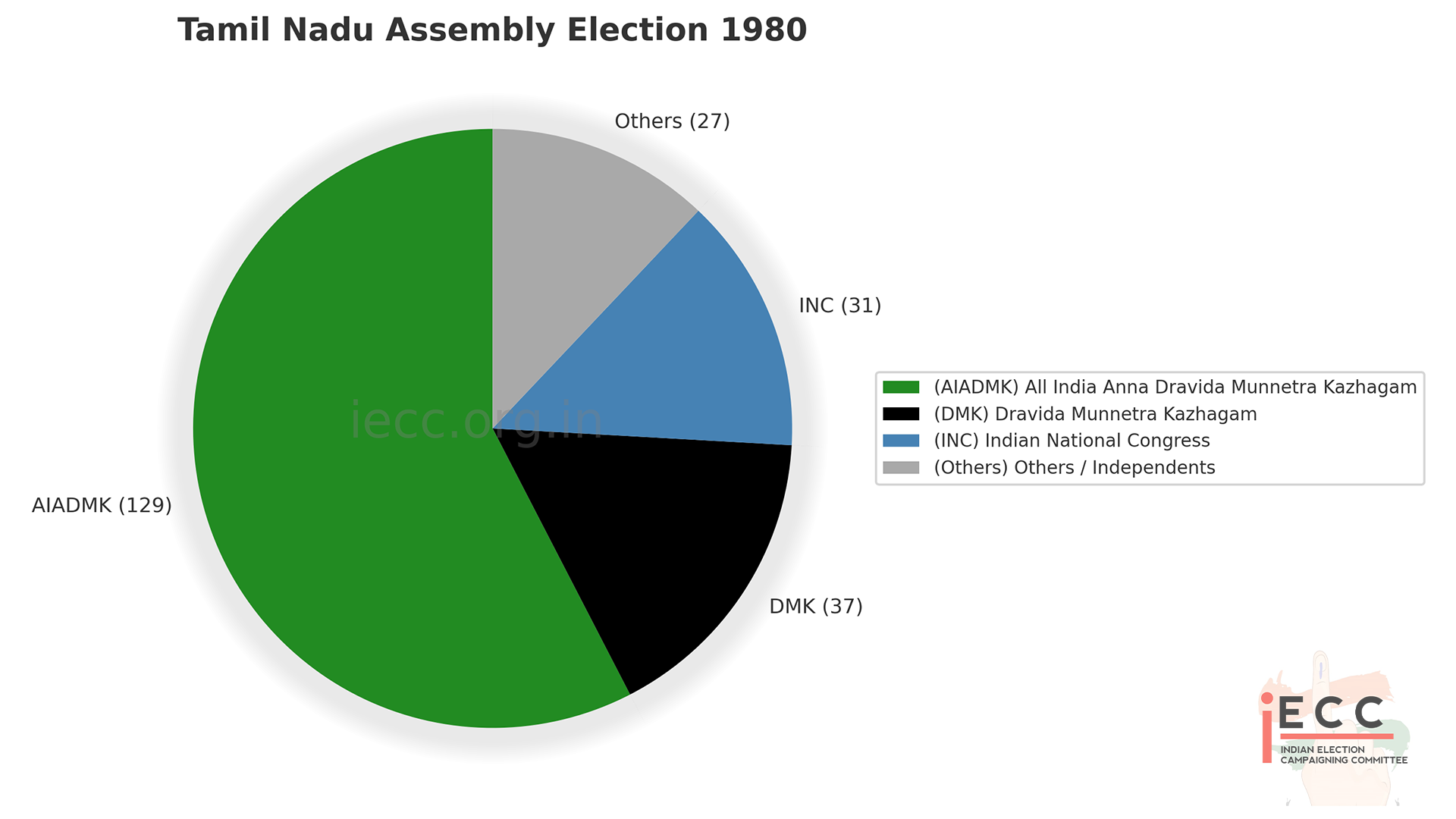
1984 Tamil Nadu Legislative Assembly Election Results
| 1984 Tamil Nadu Legislative Assembly Election Results | |||
|---|---|---|---|
| Sr. No. | Short Name | Full Name | Seats |
| 1 | AIADMK + Congress (I) | AIADMK + Congress (I) | 195 |
| 2 | DMK | DMK | 24 |
| 3 | Others / Independents | Others / Independents | 15 |
| Total | 234 | ||
This was one of the largest victories in Tamil Nadu’s history.
Despite being hospitalised, MGR’s charisma + welfare policies ensured public trust.
The Congress (I) alliance boosted the coalition’s strength due to the sympathy wave after Indira Gandhi’s assassination.
The DMK suffered badly, winning only 24 seats.
MGR became Chief Minister for the third consecutive time (1977–87), a record for the time.
This was also the last election MGR contested, as he passed away in 1987.
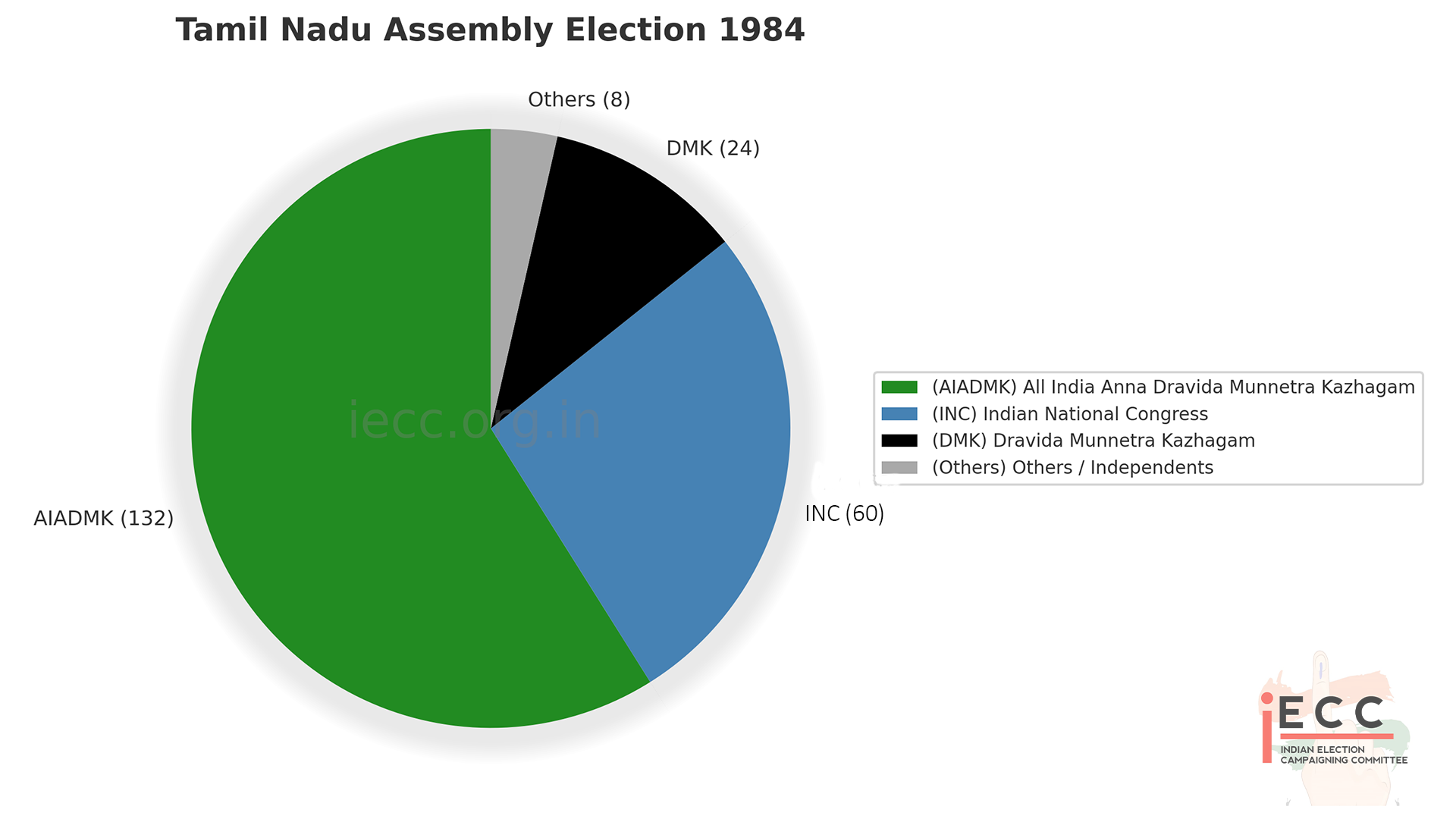
1989 Tamil Nadu Legislative Assembly Election Results
| 1989 Tamil Nadu Legislative Assembly Election Results | |||
|---|---|---|---|
| Sr. No. | Short Name | Full Name | Seats |
| 1 | DMK + Allies | DMK + Allies | 150 |
| 2 | AIADMK (Jayalalithaa faction) | AIADMK (Jayalalithaa faction) | 27 |
| 3 | AIADMK (Janaki faction) | AIADMK (Janaki faction) | 2 |
| 4 | Congress (I) | Congress (I) | 26 |
| 5 | Others / Independents | Others / Independents | 29 |
| Total | 234 | ||
The DMK swept back to power with 150 seats, securing a strong majority.
This was M. Karunanidhi’s comeback as Chief Minister after being out of power since 1976.
The AIADMK split between Janaki and Jayalalithaa led to vote division, badly damaging its chances.
Congress (I) contested on its own and won 26 seats, but did not play kingmaker.
After the election, Janaki’s faction merged back into Jayalalithaa’s AIADMK, and she emerged as the sole leader of the party.
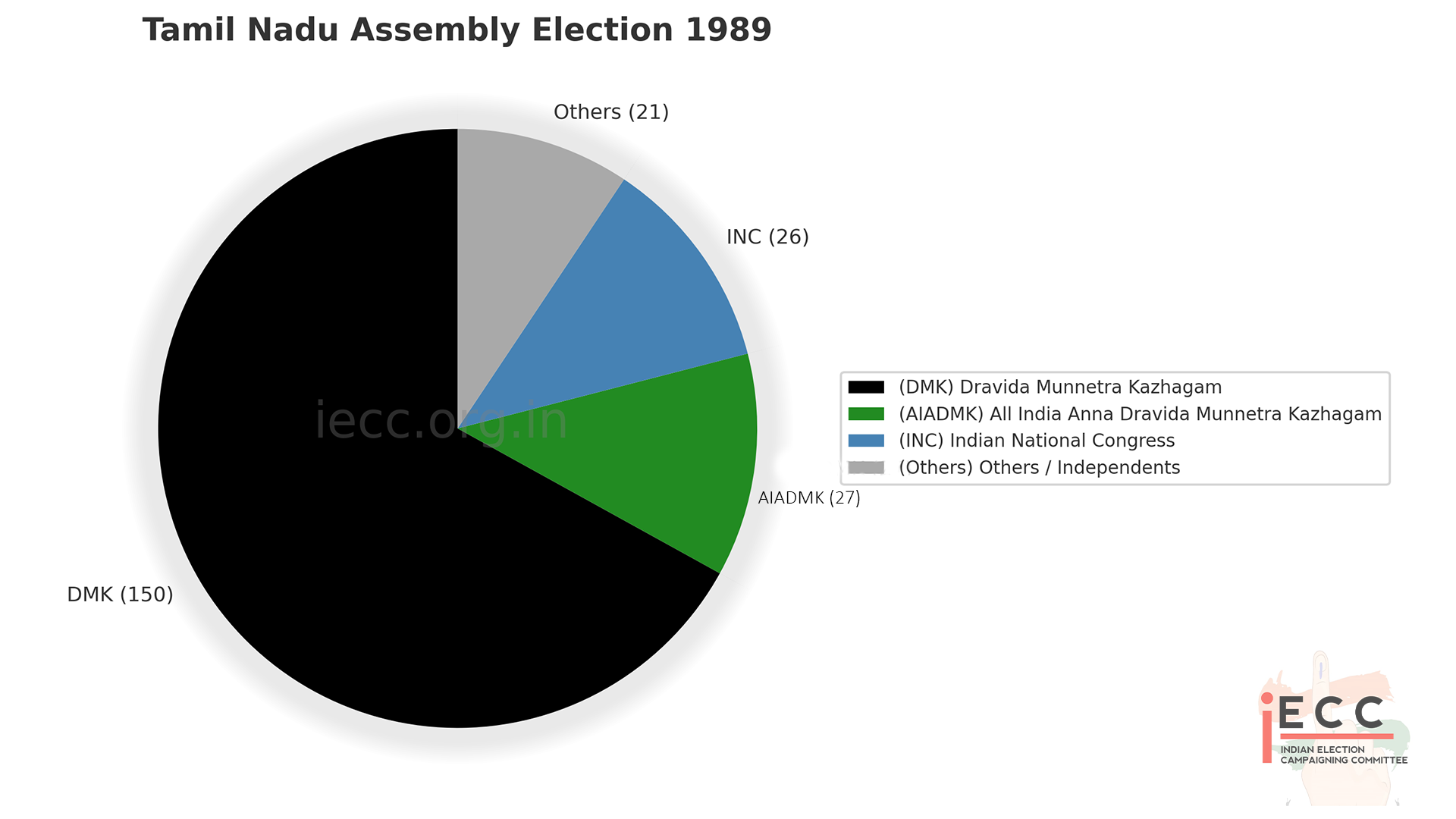
1991 Tamil Nadu Legislative Assembly Election Results
| 1991 Tamil Nadu Legislative Assembly Election Results | |||
|---|---|---|---|
| Sr. No. | Short Name | Full Name | Seats |
| 1 | AIADMK + Congress (I) Alliance | AIADMK + Congress (I) Alliance | 225 |
| 2 | DMK | DMK | 2 |
| 3 | Others / Independents | Others / Independents | 7 |
| Total | 234 | ||
This election marked the political rise of J. Jayalalithaa, who became CM for the first time.
The AIADMK–Congress (I) alliance won 225 out of 234 seats — one of the most dominant victories in Indian electoral history.
The DMK suffered a humiliating defeat, winning just 2 seats due to the LTTE controversy and anti-incumbency.
The assassination of Rajiv Gandhi created a wave of anger and sympathy, which completely shifted voter sentiment in favor of AIADMK–Congress.
This election firmly established Jayalalithaa as a key leader in Tamil Nadu politics, succeeding MGR’s legacy.

1996 Tamil Nadu Legislative Assembly Election Results
| 1996 Tamil Nadu Legislative Assembly Election Results | |||
|---|---|---|---|
| Sr. No. | Short Name | Full Name | Seats |
| 1 | DMK + TMC (Moopanar) Alliance | DMK + TMC (Moopanar) Alliance | 221 |
| 2 | AIADMK | AIADMK | 4 |
| 3 | Independents & Others | Independents & Others | 9 |
| Total | 234 | ||
The election was a total rejection of Jayalalithaa’s rule.
The DMK–TMC alliance won 221 seats, one of the biggest victories in TN’s history.
AIADMK was reduced to just 4 seats, its worst-ever performance.
Karunanidhi returned as Chief Minister (his 4th term).
This election also marked the rise of the Tamil Maanila Congress (TMC), which later became a significant regional force.
Nationally, this was the same election where AIADMK lost badly in Lok Sabha too, and Jayalalithaa’s reputation suffered long-term damage.
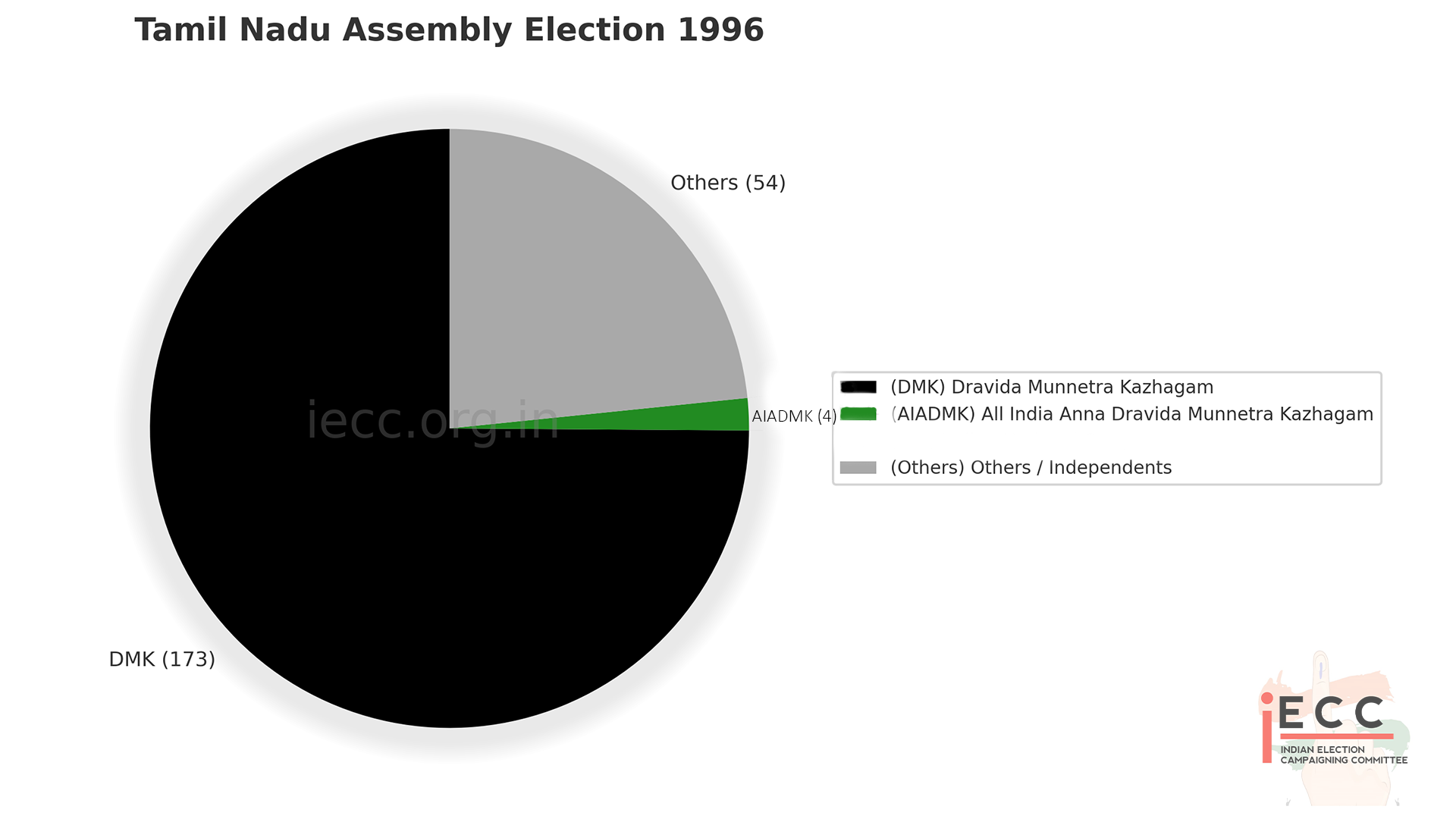
2001 Tamil Nadu Legislative Assembly Election Results
| 2001 Tamil Nadu Legislative Assembly Election Results | |||
|---|---|---|---|
| Sr. No. | Short Name | Full Name | Seats |
| 1 | AIADMK + Congress (I) Alliance | AIADMK + Congress (I) Alliance | 196 |
| 2 | DMK + BJP Alliance | DMK + BJP Alliance | 37 |
| 3 | Others / Independents | Others / Independents | 1 |
| Total | 234 | ||
The AIADMK–Congress alliance won 196 seats, giving Jayalalithaa a clear comeback.
Jayalalithaa was initially barred from becoming CM due to corruption convictions, so her aide O. Panneerselvam briefly took oath as CM.
After the Supreme Court overturned her disqualification, Jayalalithaa assumed office as CM in 2002.
The DMK–BJP alliance collapsed with just 37 seats, showing the electorate’s swing against them.
This election marked Jayalalithaa’s second term as CM, beginning a new phase in TN politics.
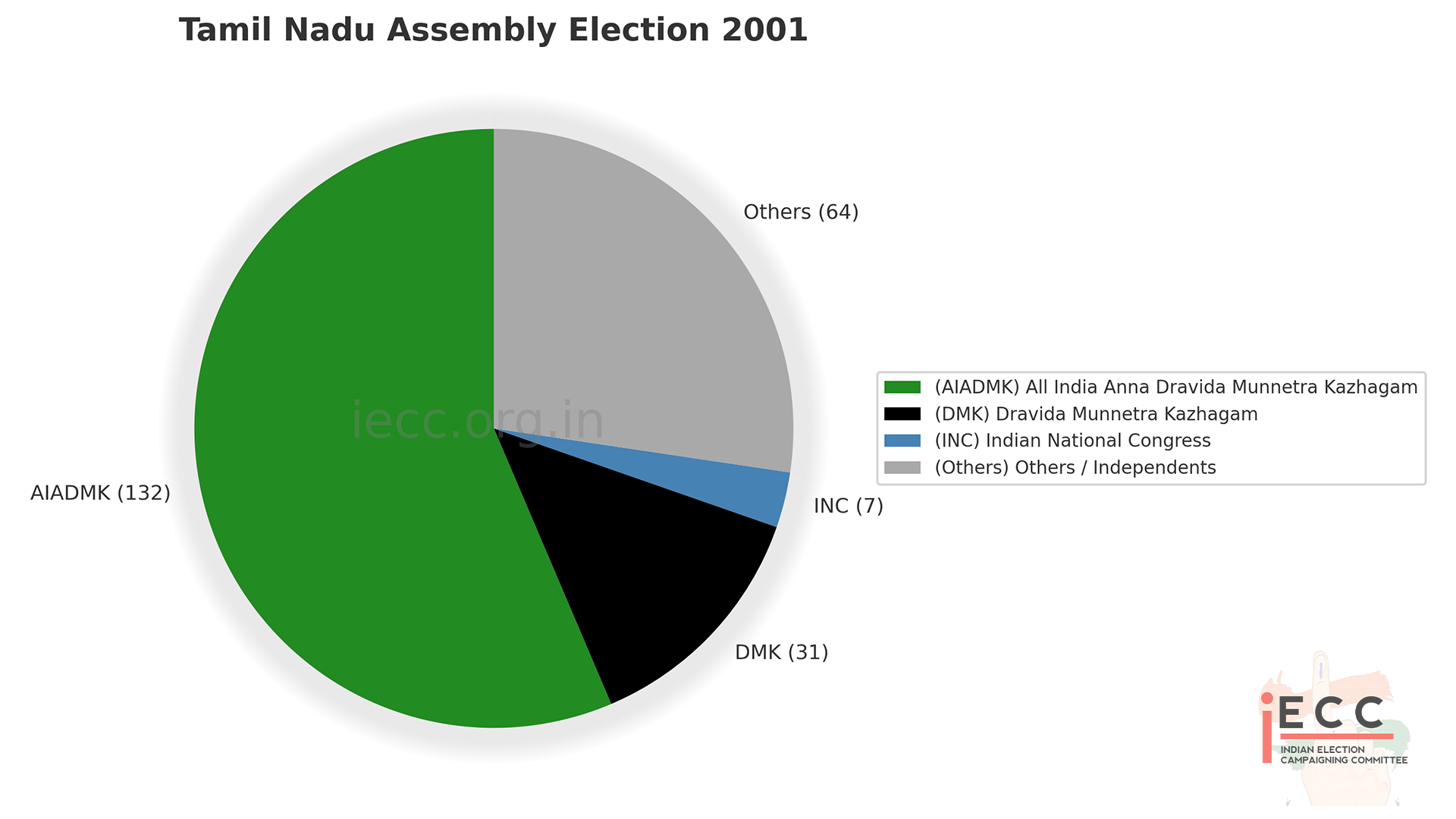
2006 Tamil Nadu Legislative Assembly Election Results
| 2006 Tamil Nadu Legislative Assembly Election Results | |||
|---|---|---|---|
| Sr. No. | Short Name | Full Name | Seats |
| 1 | DMK + Congress (I) + PMK + Left | DMK + Congress (I) + PMK + Left | 163 |
| 2 | AIADMK | AIADMK | 61 |
| 3 | Others (MDMK, Independents, etc.) | Others (MDMK, Independents, etc.) | 10 |
| Total | 234 | ||
The DMK-led alliance won 163 seats, but the DMK itself won only 96 (below majority).
With support from allies (Congress, PMK, Left), Karunanidhi formed the govt — his 5th and final term as Chief Minister.
Jayalalithaa’s AIADMK won 61 seats, remaining a powerful opposition.
This election was notable because it marked the start of coalition politics in Tamil Nadu, a shift from the earlier trend of single-party dominance.
Karunanidhi’s victory also showed his enduring relevance, even decades after first becoming CM.

2011 Tamil Nadu Legislative Assembly Election Results
| 2011 Tamil Nadu Legislative Assembly Election Results | |||
|---|---|---|---|
| Sr. No. | Short Name | Full Name | Seats |
| 1 | AIADMK + DMDK + Left + Allies | AIADMK + DMDK + Left + Allies | 203 |
| 2 | DMK + Congress (I) Alliance | DMK + Congress (I) Alliance | 31 |
| Total | 234 | ||
The AIADMK-led alliance swept 203 seats, giving Jayalalithaa a decisive victory.
Within this, AIADMK alone won 150+ seats, while its ally DMDK became the main opposition party with 29 seats.
The DMK alliance collapsed to just 31 seats, with DMK itself winning only 23.
This was the second-largest victory margin for AIADMK after 1991.
Jayalalithaa was sworn in as Chief Minister for the 4th time.
This election also marked the rise of DMDK (Vijayakanth) as a major player, although it later declined.
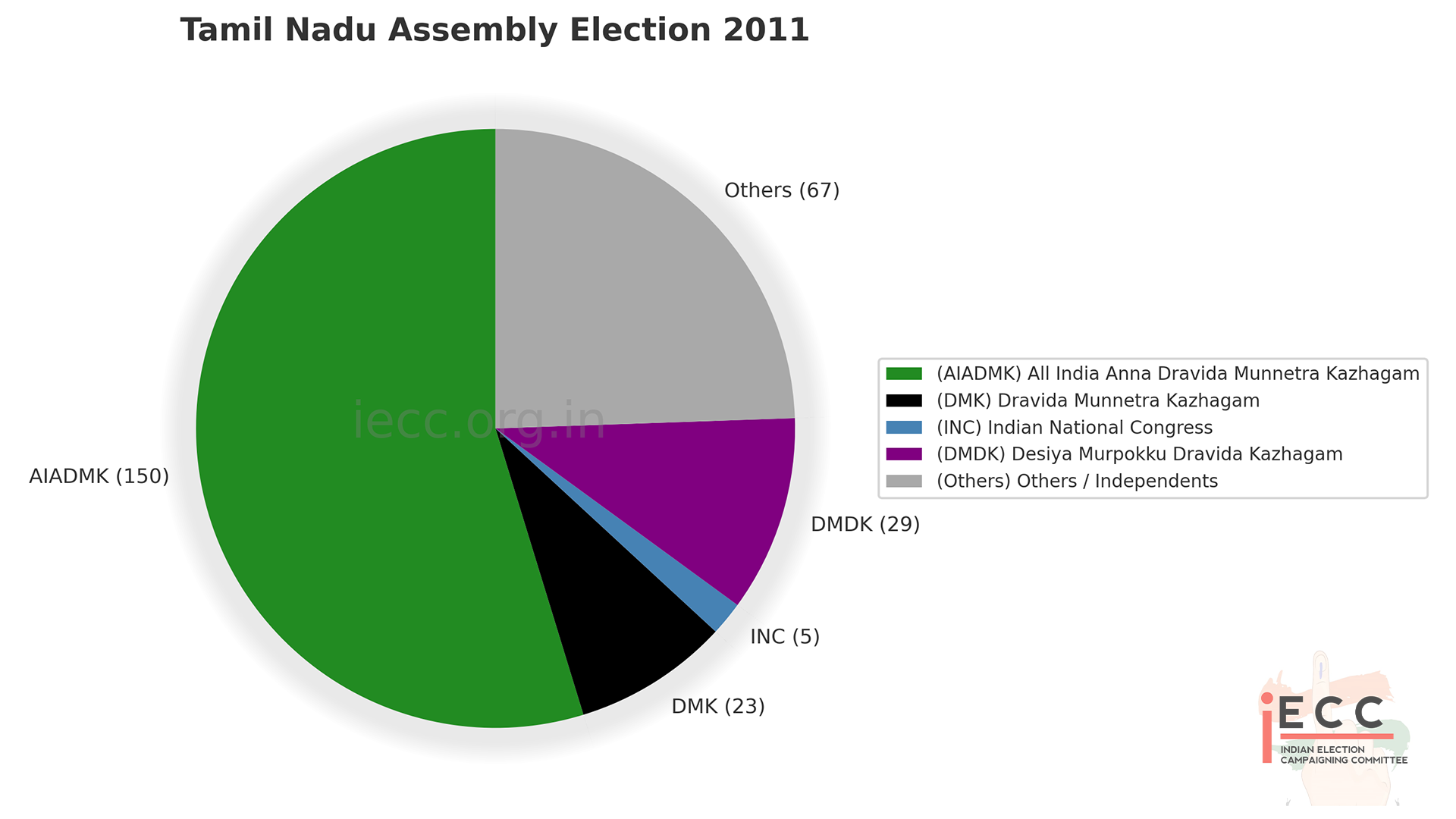
2016 Tamil Nadu Legislative Assembly Election Results
| 2016 Tamil Nadu Legislative Assembly Election Results | |||
|---|---|---|---|
| Sr. No. | Short Name | Full Name | Seats |
| 1 | AIADMK | AIADMK | 134 |
| Total | 134 | ||
AIADMK won 134 seats, just above the majority, making Jayalalithaa the first CM since 1984 to win consecutive terms.
The DMK–Congress alliance won 98 seats, a strong performance compared to 2011, with M.K. Stalin emerging as DMK’s key face.
This was Karunanidhi’s last election; he retired due to health soon after.
Jayalalithaa was sworn in as Chief Minister for the 6th time in May 2016.
Sadly, she passed away in December 2016, after which O. Panneerselvam and later Edappadi K. Palaniswami (EPS) took over as AIADMK CMs.
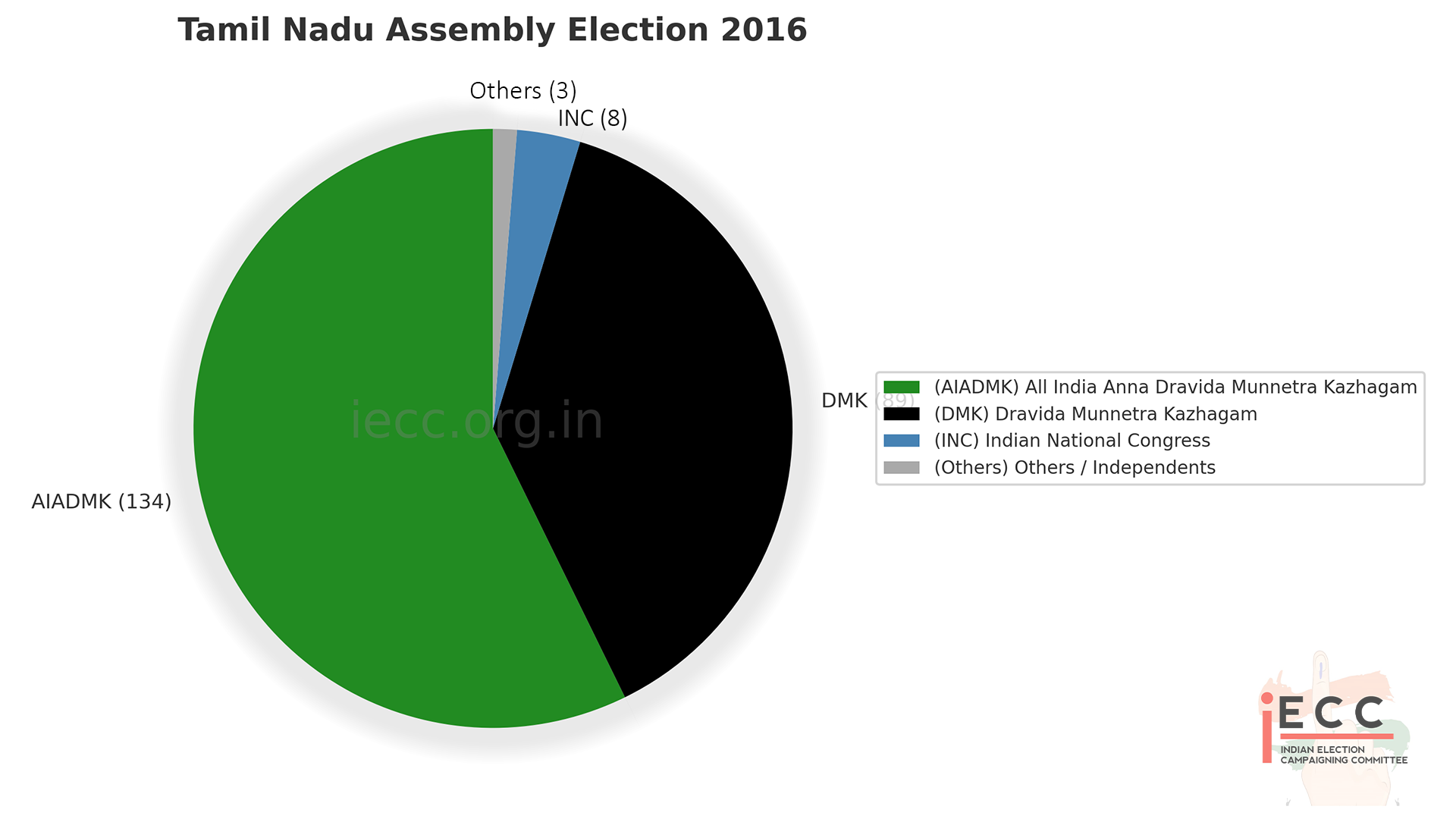
2021 Tamil Nadu Legislative Assembly Election Results
| 2021 Tamil Nadu Legislative Assembly Election Results | |||
|---|---|---|---|
| Sr. No. | Short Name | Full Name | Seats |
| 1 | DMK + Congress + Left + Allies | DMK + Congress + Left + Allies | 159 |
| 2 | AIADMK + BJP + Allies | AIADMK + BJP + Allies | 75 |
| Total | 234 | ||
The DMK-led alliance won 159 seats, giving M.K. Stalin his first Chief Ministership.
Within this, DMK alone won 133 seats, proving its individual strength.
The AIADMK alliance won 75 seats, with AIADMK at 66 and BJP at 4.
This election officially ended AIADMK’s 10-year rule (2011–2021).
The campaign emphasized welfare schemes, secularism, federal rights, and opposition to central BJP policies.
M.K. Stalin became the first CM from DMK after Karunanidhi’s last term in 2006–2011.
